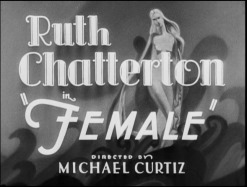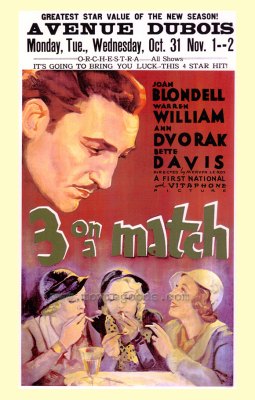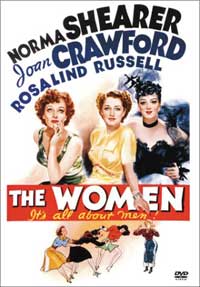1933: Female
Female (Michael Curtiz; William Dieterle; William Wellman; 1933) 7/10
 During the pre-Code era of the early 1930's, Hollywood studios cultivated an array of fast-paced pictures drenched in sin, sex and vice. Depression-era audiences flocked to their local theatres to witness the latest taboo-pushing motion picture featuring hyper-sexual dames, gun-toting gangsters and the frenzied spectacle brought on by illicit drinking, prostitution, narcotic use and racketeering. The popularity of these tawdry tales kept Hollywood afloat during the Depression, but also brought the wrath of religious and state censorship boards.
During the pre-Code era of the early 1930's, Hollywood studios cultivated an array of fast-paced pictures drenched in sin, sex and vice. Depression-era audiences flocked to their local theatres to witness the latest taboo-pushing motion picture featuring hyper-sexual dames, gun-toting gangsters and the frenzied spectacle brought on by illicit drinking, prostitution, narcotic use and racketeering. The popularity of these tawdry tales kept Hollywood afloat during the Depression, but also brought the wrath of religious and state censorship boards.One of the most daring and controversial pictures to emerge in this period was a sixty-minute film entitled Female: a novel work about the escapades of Allison Drake, a sexually vivacious female industrialist played by Ruth Chatterton. Having bequeathed her father's automobile plant through his will, Allison decides to run the plant herself. But Allison is not just a pretty face.
Punctual, efficient, intelligent and demanding, Allison expects her employees to follow her example of unrelenting professionalism and hard work. Adorned in masculinized attire and well-versed in the industry, Allison intimidates her male employees with her seemingly cold and unfeminine exterior, as she aggressively attempts to save her father's fledgling company. Unknown to the majority of her employees, she is not all work and no play. Her discreet invitations to conduct one-on-one business meetings at her spacious, art-deco home soon materialize to be far more sensual than professional affairs.
In these sequences Chatterton's character embodies the spirit of Catherine The Great. Like the famed Russian Czarina, Allison is equipped with both masculine gendered conceptions of leadership and a vigorous sexual appetite. In yearning to deal with men in a manner analogous to how men have treated women, Allison uses her power and seductive skills to utilize men less as 'household necessities' and more like pets. Her pillow strewn floor and crude electronic gadgetry enable her to entice men with vodka-fuelled sessions, before quickly dropping them from her roster the next day.
Marriage is not in the cards for Allison centrally because unlike many other women of her era, she is not financially dependent on men. Rather, her lurid affairs offer her the physical elements found in marriage through a brand of expedient satisfaction that is wholly without commitment. Repulsed by the willingness of men to believe sex equals love, Allison runs a crushingly swift program of elimination. When men do try to shower their affections upon her, Allison either ignores them or exiles them to other branches of her international empire. Allison even incorporates a system of salaried performance bonuses to pay for the additional 'labour' her male employees have exerted.
Subsequently, it was the combination of Allison's pre-marital affairs and willingness to compensate her workers for their sexual endeavours, which drew the ire of censors in the mid-Thirties and resulted in the picture being banned indefinitely until the Production Code's demise in the 1950's. Allison's liberalized sexual practices are performed without any regard for psychological burdens or notions of romance. The latter emerges in Female as a factor despised by the film's cynical and realistic protagonist, who shuns romance for its falsehoods and hyperbolic acts of flattery.
In one particularly striking scene, Allison ultimately shuns intercourse with a young artist, because of his repeated assertions of her divine status: proclaiming that she is "a goddess" basking in the heavenly atmosphere of her palatial estate with its church-like organ, extensive white walls and modern art statues.
The concept of duality and duplicity emerges as two key themes in Female. The film's repeated use of mirrors presents a concept of Allison having two sides: opposing personalities concurrently working in tandem. A masculine side is ever-present in the workplace as witnessed through her demanding demeanor and unisexual clothing. Although the masculine elements are present in the film's period ideals of sexual appetite, they are draped within sexually alluring female attire: seductive thin dresses and perfectly coiffured features.
The film's reversal of gender roles fizzles in the latter stages of Female when Allison becomes enchanted by the company's new engineer Jim Thorne (George Brent). Unlike her other male playthings, Jim is not interested in neither her money nor her sexuality. Preferring civilian work to animalistic hunting for sexual prey, Jim becomes the one entity, the omnipotent and predatory Allison cannot sink her claws into. Rather than relinquish Jim, Allison decides to win over him by playing the game: the marriage game that is.
Her subsequent actions in Female's final moments become an embarrassing farce in contrast to the film's overarching progressive ideals and sentiments. Regurgitating to a state of female stereotypes and clichés, Allison's sang froid interior cracks in a bevy of tear-soaked hysteria, yearnings to recede into a domesticated world and desires to leave the world of business to men. The closing onslaught of images including a bizarre, dreamlike picnic sequence border on the surreal. Like the memories of courtship in Alfred Hitchcock's I, Confess, this sequence in its unabashedly romantic flavour could possibly be ascertained as a mere dream, if it was not for the film's redundant finale in which Allison symbolically allows Jim to take the driver's seat in her luxury convertible.
Female was initially began by German emigre William Dieterle, who was replaced by William Wellman after the former fell ill. When Jack Warner disapproved of the actor playing one of Allison's early love interests in the film, the picture was then handed over to Michael Curtiz who, re-shot those scenes with a new actor Johnny Mack Brown and, ended up with final credit for the film. Bolstered by a brilliant, authentic lead performance by Ruth Chatterton alongside her then husband George Brent, Female still remains a feisty, groundbreaking film, which is only crippled by its regressive stance on gender in the film's closing scenes.
*Female is available on DVD exclusively through Warner Home Video's TCM Archives: Forbidden Hollywood Collection Vol. 2
Copyright 2008 8½ Cinematheque


